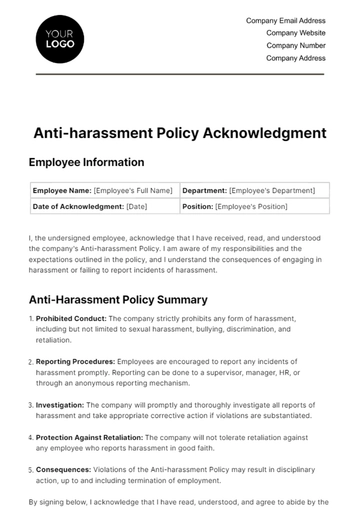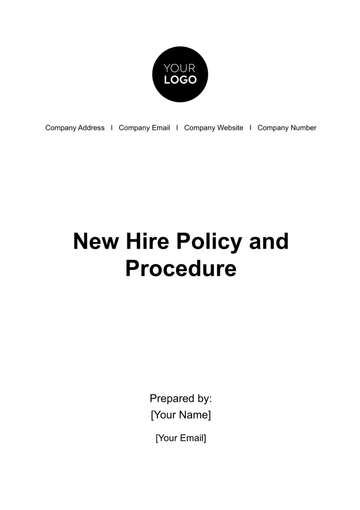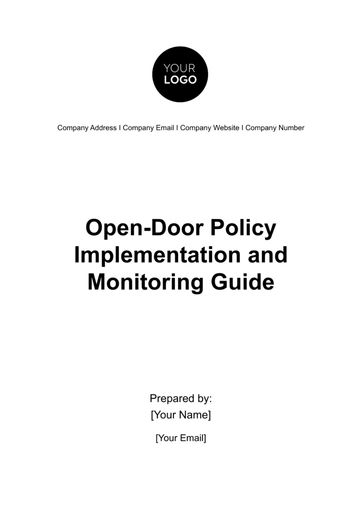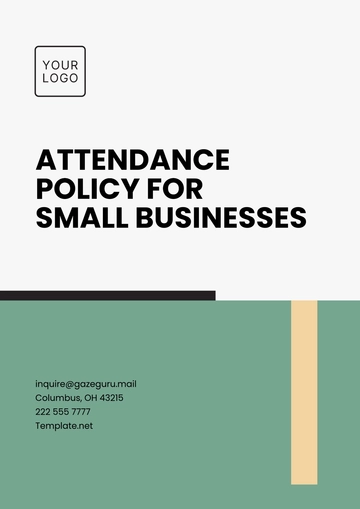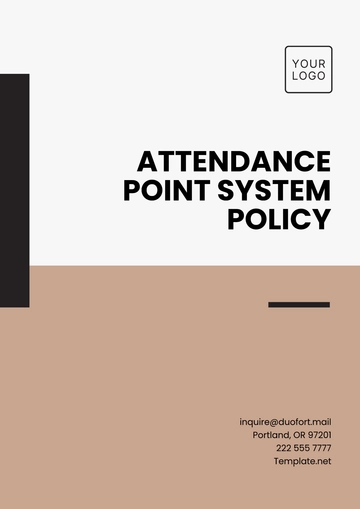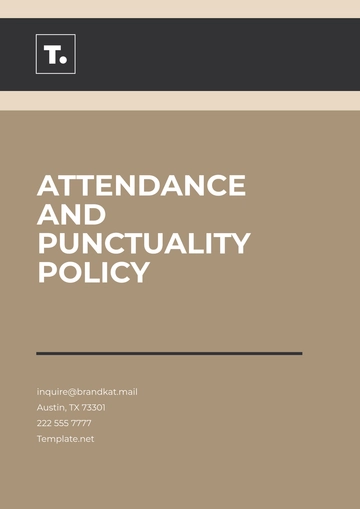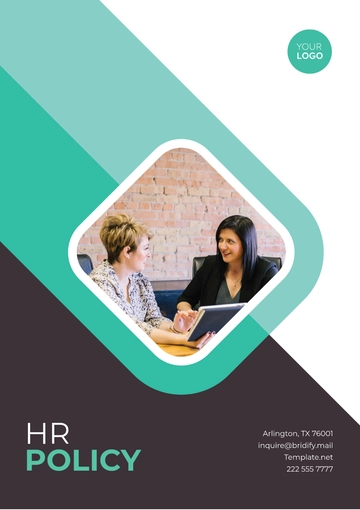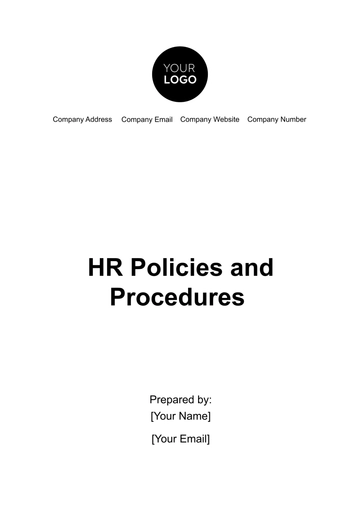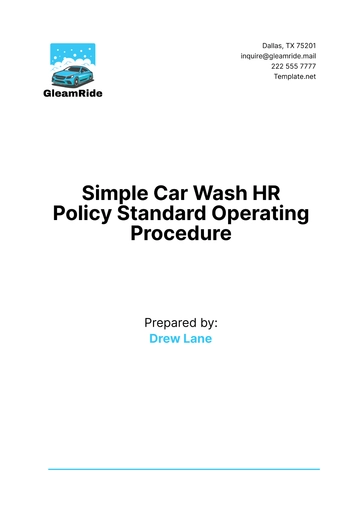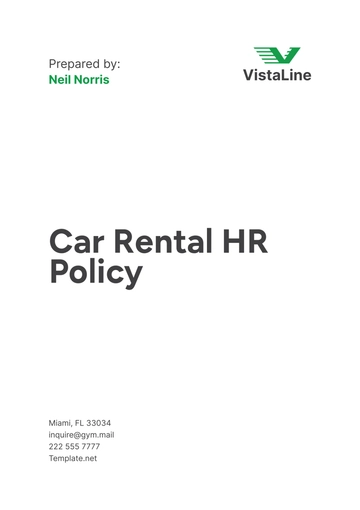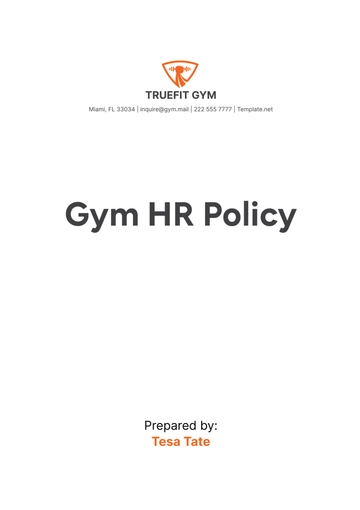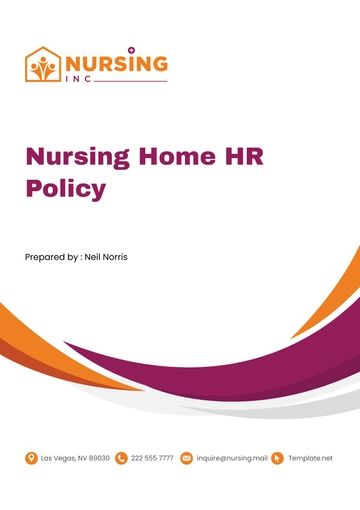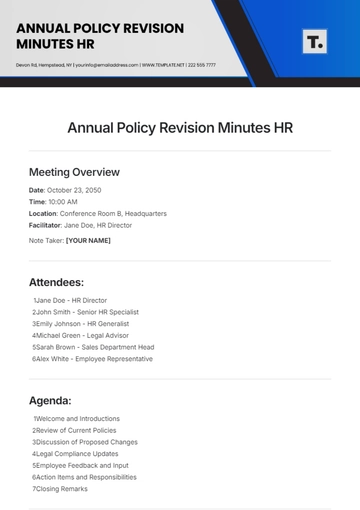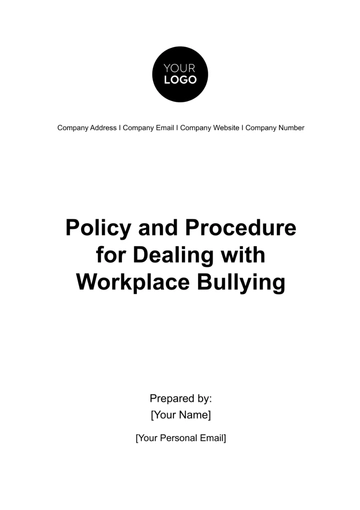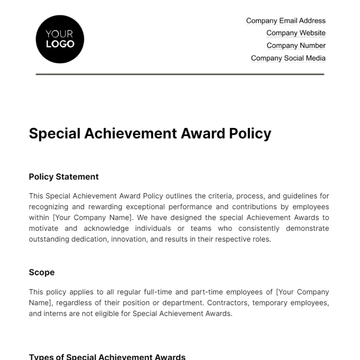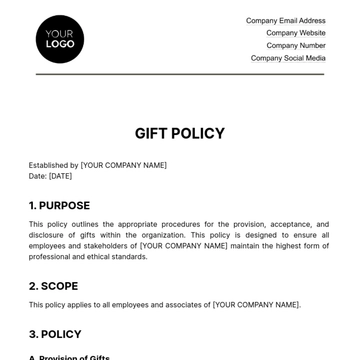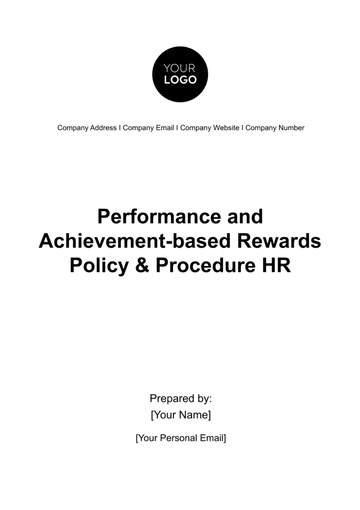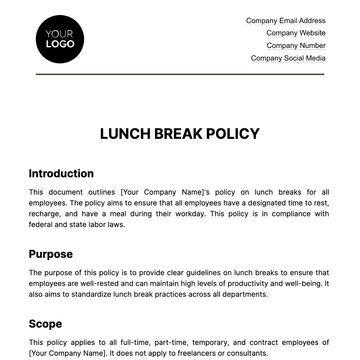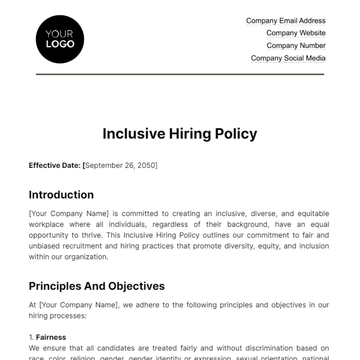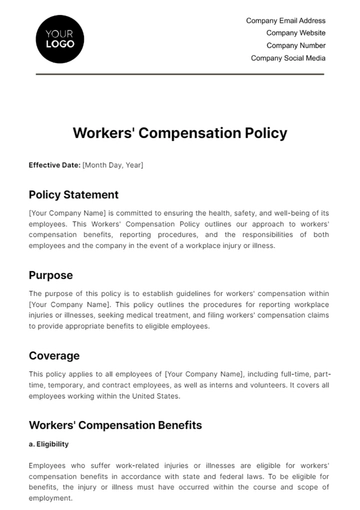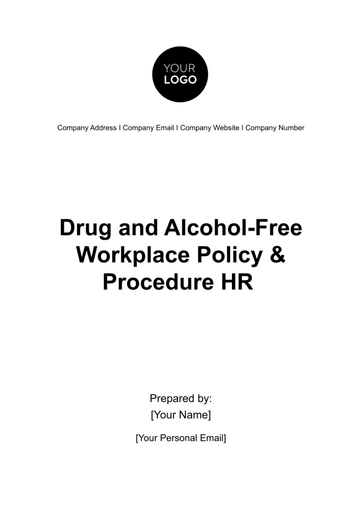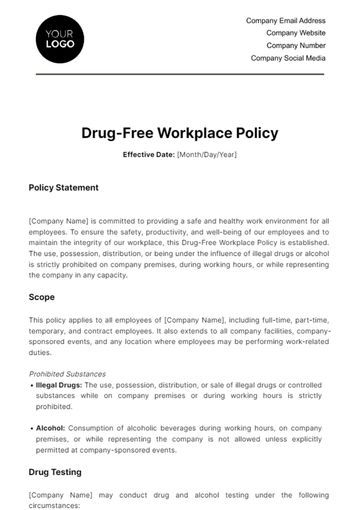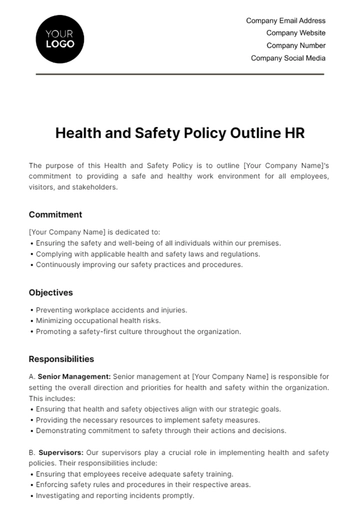Free New Hire Policy & Procedure HR

TABLE OF CONTENTS
1. Introduction 3
1.1 Purpose 3
1.2 Scope 3
1.3 Policy Owner 3
2. Recruitment and Selection 4
2.1 Job Posting 4
2.1.1 Job Description Development 4
2.1.2 Approval Process 4
2.1.3 Posting Methods 4
2.2 Candidate Sourcing 5
2.2.1 Diversity and Inclusion 5
2.2.2 Sourcing Channels 5
3. Pre-Employment 5
3.1 Background Checks 5
3.1.1 Purpose 5
3.1.2 Types of Background Checks 6
a. Criminal Background Check 6
b. Educational Verification 6
c. Employment History Verification 6
3.2 Employment Eligibility Verification (Form I-9) 6
3.2.1 Purpose 6
3.2.2 Completion of Form I-9 6
4. Orientation and Training 7
4.1 New Employee Orientation 7
4.2 Components of New Employee Orientation 7
4.2.1 Welcome and Introduction 7
4.2.2 Company Policies and Procedures 7
5. Benefits 8
5.1 Health and Wellness Benefits 8
5.1.1 Health Insurance 8
5.2 Retirement Plans 8
5.3 Paid Time Off 8
6. Performance Evaluation 9
7. Termination and Resignation 9
7.1 Resignation Process 9
7.1.1 Written Notice 9
7.1.2 Notice Period 9
7.2 Termination Process 9
7.3 Exit Interviews 10
8. Code of Conduct and Ethics 10
8.1 Company Values and Culture 10
8.1.1 Integrity 10
8.1.2 Excellence 10
8.1.3 Innovation 11
8.1.4 Respect 11
8.1.5 Accountability 11
8.1.6 Collaboration 11
8.2 Employee Code of Conduct 11
8.2.1 Integrity and Honesty 11
8.2.2 Respect and Inclusion 11
8.2.3 Confidentiality 11
8.2.4 Compliance with Laws and Regulations 12
8.2.5 Professionalism 12
9. Commitment to Safety 12
9.1 Safety Policies and Procedures 12
9.1.1 Reporting Hazards 12
9.1.2 Emergency Response 12
9.1.3 First Aid and Medical Assistance 12
9.1.4 Fire Safety 13
10. Conclusion 13
Introduction
The successful integration of new employees into [Company Name]'s workforce is critical to our continued growth, innovation, and success. This New Hire Policy & Procedure has been developed to establish clear guidelines and processes for recruiting, hiring, and onboarding new personnel. This document outlines the essential steps and expectations for both new hires and the organization, ensuring a consistent and positive experience while adhering to legal and ethical standards.
1.1 Purpose
The primary purpose of this New Hire Policy & Procedure is to:
Streamline the recruitment and selection process to attract the best talent.
Provide a structured framework for onboarding new employees.
Ensure that all new hires receive consistent information about company policies, culture, and expectations.
Comply with all relevant labor laws, regulations, and industry standards.
Promote a welcoming and inclusive work environment that fosters employee satisfaction and retention.
This policy aims to support the company's mission by fostering a collaborative, efficient, and productive workforce and by setting clear expectations for all employees from their first day onward.
1.2 Scope
This policy applies to all individuals who join [Company Name] as employees, including but not limited to full-time, part-time, temporary, and contract workers. It encompasses the entire lifecycle of employment, from the initial recruitment process to orientation, training, benefits, performance evaluation, and, when necessary, termination.
Every department and employee involved in the recruitment, selection, onboarding, and management of new hires is expected to follow the guidelines and procedures outlined in this policy. Compliance with this policy is mandatory for all employees and is essential for maintaining consistency, fairness, and compliance across the organization.
1.3 Policy Owner
The ownership, oversight, and continuous improvement of this New Hire Policy & Procedure are the responsibility of the Human Resources (HR) Department. HR is committed to providing guidance, support, and resources to hiring managers, employees, and new hires to ensure the successful implementation of this policy. All inquiries, concerns, suggestions, or requests for clarification regarding this policy should be directed to the HR Department, which can be reached at [Company Number].
[Company Name] recognizes the critical role that HR plays in ensuring that our workforce remains skilled, motivated, and aligned with our values and objectives. This New Hire Policy & Procedure is a testament to our commitment to nurturing a dynamic and inclusive workplace that fosters professional growth and innovation.
Recruitment and Selection
2.1 Job Posting
2.1.1 Job Description Development
Before initiating the recruitment process, [Company Name] places great emphasis on creating clear and comprehensive job descriptions for all open positions. The job description serves as a fundamental document that outlines the role's responsibilities, qualifications, and expectations. This document is developed collaboratively by the hiring manager and the Human Resources (HR) Department to ensure that it accurately reflects the needs of the organization.
2.1.2 Approval Process
All job postings must be approved by the HR Department before they are advertised externally. This approval process includes a review of the job description, compensation details, and any specific requirements for the position. HR may provide guidance to ensure compliance with labor laws, equal employment opportunity guidelines, and industry standards.
2.1.3 Posting Methods
[Company Name] utilizes various methods to post job openings, including but not limited to:
Company Website: All job openings are posted on the [Company Name] website, where interested candidates can learn about the company and apply directly.
Job Boards and Platforms: We also use reputable job boards and online platforms to reach a broader audience, ensuring visibility among potential candidates.
Internal Posting: [Company Name] encourages internal candidates to apply for job openings before external recruitment begins. This promotes career development and internal mobility within the organization.
2.2 Candidate Sourcing
2.2.1 Diversity and Inclusion
At [Company Name], we are committed to building a diverse and inclusive workforce. Our candidate sourcing efforts are aligned with this commitment. We actively seek candidates from various backgrounds, cultures, and experiences to foster creativity, innovation, and a richer company culture.
2.2.2 Sourcing Channels
To attract top talent, we utilize a variety of sourcing channels, including but not limited to:
Online Job Portals: [Company Name] posts job openings on reputable job boards, professional networks, and industry-specific websites.
Employee Referrals: We encourage employees to refer qualified candidates, offering incentives for successful referrals.
Recruitment Agencies: On occasion, we partner with recruitment agencies specializing in IT and related fields to identify potential candidates.
Networking Events: We actively participate in industry events, conferences, and networking sessions to establish connections with potential candidates.
Pre-Employment
3.1 Background Checks
3.1.1 Purpose
[Company Name] conducts background checks on all potential employees to ensure that individuals hired to meet the company's standards for trustworthiness, professionalism, and suitability for the position. Background checks are an essential part of our commitment to maintaining a secure and productive work environment.
3.1.2 Types of Background Checks
a. Criminal Background Check
All candidates are subject to a criminal background check, which includes:
A review of any criminal convictions, if applicable.
Verification of the candidate's identity through a government-issued ID.
b. Educational Verification
For positions that require specific educational qualifications, [Company Name] will verify the candidate's educational credentials. This includes:
Confirming the authenticity of degrees or certifications.
Checking the educational institution's accreditation status.
c. Employment History Verification
[Company Name] verifies candidates' employment history to confirm their previous work experience and job responsibilities. This includes:
Contacting former employers to verify job titles and dates of employment.
Assessing any gaps in employment.
3.2 Employment Eligibility Verification (Form I-9)
3.2.1 Purpose
[Company Name] is committed to complying with all federal immigration laws and requires all employees to complete Form I-9, "Employment Eligibility Verification," to verify their identity and eligibility to work in the United States. This form is completed for every new hire, regardless of their citizenship or immigration status.
3.2.2 Completion of Form I-9
New employees are required to complete Section 1 of Form I-9 on or before their first day of employment. They must present valid and unexpired documentation that establishes both identity and employment authorization. The HR Department will guide employees through this process, ensuring that all required documents are provided and accurately recorded on the form.
Orientation and Training
4.1 New Employee Orientation
New Employee Orientation (NEO) at [Company Name] is a crucial component of our commitment to providing a seamless transition for new hires into the organization. The purpose of NEO is to:
Introduce Company Culture: NEO familiarizes new employees with [Company Name]'s mission, values, culture, and long-term goals.
Provide Essential Information: It offers essential information about company policies, benefits, and resources to empower new hires to thrive in their roles.
Foster Engagement: NEO helps establish a sense of belonging and engagement within the organization by facilitating connections with colleagues and managers.
4.2 Components of New Employee Orientation
4.2.1 Welcome and Introduction
Welcome Address: New employees are greeted with a warm welcome from company leadership or a designated representative.
Introduction to the Company: An overview of the company's history, mission, values, and organizational structure is presented.
4.2.2 Company Policies and Procedures
Employee Handbook: New hires receive a copy of the employee handbook and are guided through its contents. Topics include but are not limited to:
Code of conduct
Work hours and attendance policies
Communication guidelines
Anti-harassment and anti-discrimination policies
Benefits
5.1 Health and Wellness Benefits
5.1.1 Health Insurance
[Company Name] is committed to the health and well-being of our employees and offers a comprehensive health insurance package. Key features of our health insurance benefits include:
Medical Coverage: Employees and their eligible dependents have access to a wide network of healthcare providers, ensuring quality medical care.
Dental and Vision Insurance: Our plans include dental and vision coverage to maintain your overall health.
Prescription Drug Coverage: Access to a range of prescription medications at affordable rates.
5.2 Retirement Plans
[Company Name] offers a 401(k) retirement plan to help employees save for their future. Key features of our 401(k) plan include:
Employee Contributions: Eligible employees can make pre-tax contributions to their retirement accounts.
Employer Matching: [Company Name] matches a portion of employee contributions, helping to accelerate retirement savings.
Vesting Schedule: Employees become fully vested in their employer contributions over time.
5.3 Paid Time Off
[Company Name] recognizes the importance of work-life balance and offers a competitive vacation policy. Our paid time off (PTO) program includes:
Accrual System: Employees accrue vacation days based on their length of service with the company.
Carryover: The option to carry over a portion of unused vacation days from one year to the next, subject to limitations.
Paid Holidays: In addition to vacation days, employees enjoy paid holidays, including [list of company holidays].
Performance Evaluation
Performance reviews at [Company Name] are a fundamental aspect of our commitment to fostering professional growth, recognizing achievements, and maintaining a high-performance culture. The purpose of performance reviews is to:
Assess Progress: Evaluate employee performance, contributions, and progress toward established goals and objectives.
Provide Feedback: Offer constructive feedback on strengths, areas for improvement, and areas where additional support may be needed.
Set Expectations: Clarify performance expectations, goals, and development opportunities for the upcoming performance period.
Recognize Achievements: Acknowledge and reward exceptional performance and contributions to the organization.
Termination and Resignation
7.1 Resignation Process
Employees wishing to resign from their position at [Company Name] are expected to follow these guidelines:
7.1.1 Written Notice
Employees must submit a written resignation letter to their immediate supervisor or manager. The letter should include the effective date of resignation, reasons for resigning (optional), and an expression of gratitude for the opportunity to work at the company.
7.1.2 Notice Period
Depending on the position and circumstances, employees may be required to provide notice of their intent to resign. The notice period is typically [mention the notice period, e.g., two weeks], but it may vary based on the employment contract.
7.2 Termination Process
Termination of employment at [Company Name] may occur for various reasons, including but not limited to:
Performance Issues: Termination may result from sustained performance below acceptable standards despite coaching and improvement plans.
Violations of Policies: Disregard for company policies, including code of conduct, harassment, or data security policies, may lead to termination.
Misconduct: Serious misconduct, such as theft, fraud, violence, or harassment, may result in immediate termination.
Redundancy or Restructuring: Economic or operational reasons may necessitate employee layoffs or position eliminations.
7.3 Exit Interviews
Exit interviews at [Company Name] are conducted to gain insights into the employee's experience and feedback regarding their time with the company. The purpose of exit interviews is to:
Understand the reasons for resignation or termination.
Identify areas for improvement in company policies, procedures, and culture.
Ensure a smooth transition and knowledge transfer if the employee's departure impacts ongoing projects or tasks.
Code of Conduct and Ethics
8.1 Company Values and Culture
At [Company Name], we are committed to maintaining a workplace that reflects our core values and embodies a strong ethical culture. Our values are the foundation of our company, guiding our decisions, actions, and interactions with each other, our clients, and our partners. These values are:
8.1.1 Integrity
We uphold the highest standards of honesty, transparency, and ethical behavior. We are committed to doing the right thing, even when it's difficult.
8.1.2 Excellence
We strive for excellence in everything we do. We continually seek opportunities to improve our skills, processes, and services to deliver outstanding results to our clients and stakeholders.
8.1.3 Innovation
We foster a culture of innovation and creativity. We encourage our employees to think outside the box, embrace change, and drive continuous improvement.
8.1.4 Respect
We treat everyone with respect and dignity, valuing diversity and inclusion. We create an environment where all employees feel valued, safe, and empowered to contribute their best.
8.1.5 Accountability
We take ownership of our actions and responsibilities. We deliver on our commitments, and when we make mistakes, we learn from them and take corrective actions.
8.1.6 Collaboration
We believe in the power of teamwork and collaboration. We work together, share knowledge, and leverage each other's strengths to achieve our goals.
8.2 Employee Code of Conduct
Our Employee Code of Conduct is a set of principles and guidelines that all employees at [Company Name] are expected to follow. These principles reflect our values and help us maintain a culture of integrity, professionalism, and ethical behavior.
8.2.1 Integrity and Honesty
We conduct ourselves with honesty, integrity, and transparency in all our interactions, both within and outside the organization.
8.2.2 Respect and Inclusion
We treat all colleagues, clients, and stakeholders with respect, valuing diversity and fostering an inclusive environment free from discrimination, harassment, or bias.
8.2.3 Confidentiality
We protect sensitive and confidential company information, as well as client and employee data, and use it solely for legitimate business purposes.
8.2.4 Compliance with Laws and Regulations
We adhere to all applicable laws, regulations, and industry standards. If uncertain about the legality of a situation, we seek guidance from the appropriate channels.
8.2.5 Professionalism
We maintain a high level of professionalism in our behavior, appearance, communication, and interactions with colleagues and clients.
8.2.6 Conflict of Interest
We avoid conflicts of interest and disclose any potential conflicts to management. We do not use our position at [Company Name] for personal gain or to benefit family members or close associates.
Commitment to Safety
At [Company Name], the safety and well-being of our employees are of paramount importance. We are committed to maintaining a safe and healthy workplace for all employees, visitors, and contractors. Our commitment extends to ensuring the safety of our physical premises, and equipment, and the protection of sensitive information.
9.1 Safety Policies and Procedures
9.1.1 Reporting Hazards
All employees are encouraged to promptly report any safety hazards, potential risks, or unsafe conditions to their supervisors, managers, or the HR Department.
9.1.2 Emergency Response
[Company Name] has established emergency response procedures that all employees must be familiar with. These procedures cover responses to fires, medical emergencies, natural disasters, and security incidents.
9.1.3 First Aid and Medical Assistance
First aid kits are available throughout the workplace, and designated employees are trained to provide basic first aid when needed. In the event of a medical emergency, employees should call [Company Number] for immediate assistance.
9.1.4 Fire Safety
Fire safety measures, including fire extinguishers, evacuation routes, and fire drills, are in place to ensure the safety of employees in case of a fire emergency.
Conclusion
In conclusion, [Company Name] is committed to fostering a work environment that embodies our core values of integrity, excellence, innovation, respect, accountability, and collaboration. We believe that by adhering to these values and the policies and procedures outlined in this handbook, we can create a workplace where all employees can thrive, contribute their best, and grow both personally and professionally.
Our comprehensive policies and procedures are designed to provide guidance, transparency, and consistency in how we operate and interact within the organization. They cover a wide range of areas, including recruitment and selection, orientation and training, benefits, performance evaluation, termination and resignation, safety and security, and more. These policies not only reflect our commitment to ethical and responsible business practices but also ensure that we are compliant with relevant laws and regulations.
As a member of the [Company Name] team, each employee has a responsibility to familiarize themselves with the contents of this handbook and to adhere to its principles and guidelines. By doing so, we can maintain a positive and inclusive work culture that promotes respect, fairness, and equal opportunities for all.
We understand that policies and procedures may need to evolve over time to meet the changing needs of our organization and the industry in which we operate. We encourage all employees to actively engage in this process by providing feedback, sharing insights, and suggesting improvements. Your input is invaluable in helping us refine our practices and uphold the high standards we have set for ourselves.
[Company Name] is dedicated to creating a workplace where each employee feels valued, safe, and empowered to achieve their fullest potential. We are committed to promoting diversity and inclusion, fostering innovation, and maintaining a strong ethical culture. Together, we can work towards a future of growth, success, and shared achievements.
Thank you for being a part of the [Company Name] family and for your dedication to our shared vision and values.
- 100% Customizable, free editor
- Access 1 Million+ Templates, photo’s & graphics
- Download or share as a template
- Click and replace photos, graphics, text, backgrounds
- Resize, crop, AI write & more
- Access advanced editor
Welcome new hires seamlessly with our New Hire Policy & Procedure HR Template. Craft a comprehensive guide covering company policies and onboarding procedures. Streamline HR processes, ensure consistency, and empower new employees with vital information. Elevate your onboarding experience and set the stage for success with this essential tool.
You may also like
- HR Policy
- Restaurant Policy
- Company Policy
- Accounting Policies and Procedures
- Website Policy
- Privacy Policy
- Safety Policy
- School Policy
- IT and Software Policy
- Law Firm Policy
- Construction Policy
- Interior Design Policy
- Travel Agency Policy
- Education Academic Policy
- Security Policy
- Real Estate Policy
- Expense Policy
- Software Policy
